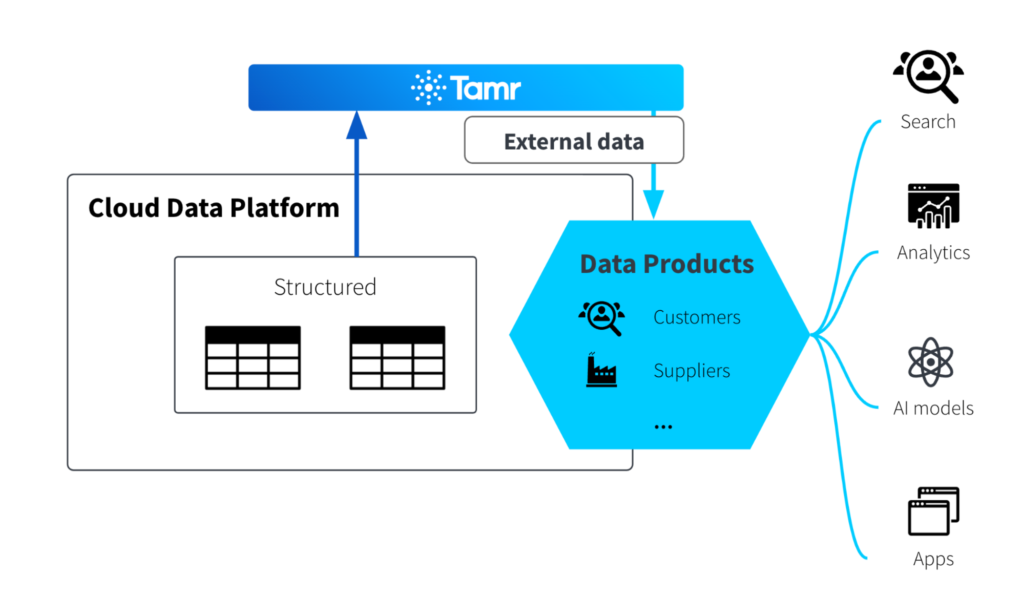Tamr Cloud
Businesses of all sizes have invested much in their data strategy and infrastructure because they know how vital accurate, complete, and current company data is. The recent advances in generative AI make high-quality data increasingly important. Nevertheless, a lot of businesses have discovered that as their data footprint expands, they are unable to reap the benefits of their data because the important individuals, businesses, suppliers, and goods that make up their enterprise are dispersed across dozens or even hundreds of databases and operational systems. Businesses have been attempting to address this very difficult problem for decades using rules- and governance-based master data management initiatives, whether through conventional MDM software or do-it-yourself and in-house solutions, with surprisingly little success.
The good news is that this seemingly unsolvable issue is finally being addressed by AI-powered solutions in a way that quickly generates economic value. Now, businesses may match data entities from many source systems to provide the reliable golden records required to enhance analytics, spur growth, and boost productivity. Furthermore, they can complete this task in a few weeks as opposed to months, years, or never. It’s crucial to look into the specifics of this issue and its resolution in order to learn more about it.
The issue with duplicate entities
Managing entity duplication presents the first obstacle to accessing reliable golden records. Delivering reliable reports can be hampered by significant customer record duplication, even within the same system. This is the “hard problem,” as Google Cloud at Tamr refer to it, which starts when an organisation needs to determine which aspects of their dataset have the necessary information to determine whether two entries correspond to the same entity. When it comes to solving the problem collectively, different data sources become increasingly more complex.
Tamr data
Data organisations are frequently forced to create intricate rules-based ETL pipelines with follow-on rules for how to combine records into a single entity in an effort to arrange data identically due to differences in schema structure, and specifically information granularity. Take two tables, for instance, one that includes a column for each of the first, middle, and last names, and the other that only has the name in its whole. This data is hard to retain, prone to errors, and especially harder to tune given data drift during deduping.
Tamr provides AI-powered Data Products that, among other things, provide precise, enterprise-wide entity resolution and golden record creation at scale for important data domains including supplier, customer, and contact data. These products are designed to tackle this challenging problem. Using ML-based mastery models, data cleaning and standardisation services, and enrichment with well-known reference datasets, these turnkey, templated software solutions enhance company-wide data. Tamr’s Data Products may give end users high-quality results by using domain-specific pipelines and machine learning models to translate user input data onto a standard schema for a certain domain. These solutions operate in a hosted SaaS environment and require little to no coding configuration.

Using AI to improve data resolution
Although Tamr has been using machine learning (ML) since 2013 to perform bottom-up data mastering (golden record creation) through the consolidation of frequently incompatible and disparate schema formats and classification, Google Cloud has improved Google Cloud’s Data Products to make use of Google Vertex AI and cutting-edge foundation models like Gemini to resolve those data items to real-world entities by utilising the semantic information present in the source systems.
Advanced huge language model Gemini from Google outperforms earlier versions in tasks including algebra, coding, classification, translation, and natural language production. Improved scalability, a variety of datasets, and the architecture of the model are credited with its success.
Gaining value from a wider range of increasingly diversified data sources is made much easier by these capabilities. Tamr’s Data Products use foundation models to resolve data to real-world entities by utilising the semantic information provided in the source systems.
Furthermore, the full potential of the source data may now be realised with Gemini without the need for traditional ML model building or ETL. To put it succinctly, Tamr‘s Data Products can accomplish more with Google’s generative AI while preserving an easy-to-use declarative configuration and production deployment experience:

Use cases
Consider the example of an e-commerce company that wishes to gain a better understanding of their sales trends in order to demonstrate how Google’s generative AI capabilities are augmenting Tamr‘s Data Products.
This company needs to know which items work best in which market categories, but there isn’t enough trustworthy information in their product catalogue to support their analysis. A large portion of this data is directly encoded into product names.
Integrate generative AI to improve data management
The collaboration between Tamr and Google is a major advancement in analytics and data management. Businesses can simply convert their data and overcome the obstacles of resolving records from various data sources by combining Google’s cutting-edge generative AI, such as Gemini, with Tamr‘s Data Products.
With little to no code configuration needed, Tamr‘s turnkey Data Products make use of ML-based mastering models, data cleaning, standardisation services, and reference datasets. The hosted SaaS environment adds to this simplicity and makes it easier for users to use.
Google’s generative AI is integrated, offering hitherto unheard-of possibilities. It makes it possible to automatically extract structured data from unstructured text fields and gives users the efficiency to complete a variety of categorization jobs. Without the need for intricate ETL processes or substantial ML model development, data may be precisely resolved to real-world entities by utilising the semantic information extracted from source systems.
By streamlining data management, speeding up time-to-value, and improving data-driven insights, Google and Tamr work together to deliver better value. While preserving the quality and integrity of their data, businesses may maximise its value, expedite data processing, and make better decisions.
The collaboration between Google and Tamr elevates data analytics and management to new levels, assisting businesses in thriving in a highly data-dependent, competitive, and ever-complex environment.


